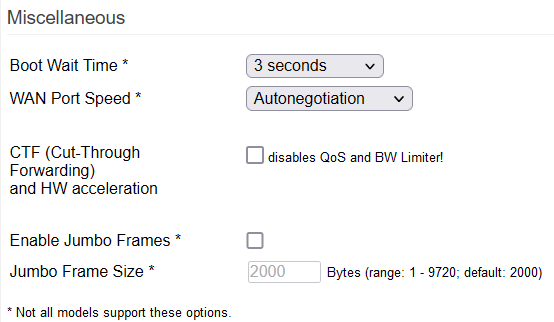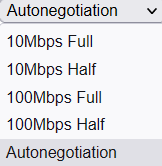User Tools
Sidebar
This is an old revision of the document!
Miscellaneous
This page allows you to tweak some secondary settings. These settings rarely need to be modified. If you change them, make sure you understand the consequences of doing so.
Boot Wait Time * - This is the time period when a router can be accessed using the included CFE webserver. This refers to the bootstrap portion of the process, or the loading of code before the Operating system loads. If you need to delay FreshTomato's boot process (and stay in internal webserver CFE mode), this is the setting to change. In unusual circumstances, such as a power outage, your modem might take longer to boot than FreshTomato does. This setting would be used to tune that until it is optimal.

WAN Port Speed * - This allows you to choose either Autonegotiate (Default) mode on the WAN port, or force a specific combination of speed/duplex for the WAN port. Note that you can only force 10Mbps and 100Mbps. For 1Gpbs, leave the setting on Autonegotiate.

CTF (Cut-Through Forwarding) - If checked, this enables hardware acceleration. CTF uses an alternative forwarding method to Store and Forward in bridges.
For example, CTF could allow you to use your FreshTomato device in a Gigabit WAN environment. With CTF disabled (Default), WAN-to-LAN performance depends on the hardware model in use. On ARM devices, you can expect performance in the range of 200 to 400 Mb/s.
Note that enabling CTF will disable QoS and Bandwidth Limiter. This happens because the switching part of the packet bypasses parts of the standard Linux iptable chains.
- ARM Routers (like the RT-AC68U, RT-AC3200, R7000) support CTF.
- MIPS RT-N routers (like the E4200v1, RT-N16) can use Broadcom FastNAT
- FastNAT is a similar function to forward at accelerated speeds.
- MIPS RT-AC routers (like the RT-AC66U) do not support CTF or FastNAT.
Enable Jumbo Frames * - This option allows you to increase the maximum frame size within your LAN. (Default: off).
The default Jumbo Frames size is 2000 bytes.
If this option is enabled, all ports (WAN + LAN) will have jumbo frame capability enabled.
NOTE: The Jumbo Frame feature is only supported in 1000 Mbit/s mode.
NOTE 2: The gigabit switch needs more memory for this feature. This can/will influence the system performance (depending on how many ports simultaneously use jumbo frames)
Jumbo Frame Size * - If this setting is disabled, the default frame size is 2000 bytes. If Jumbo Frame Size is enabled, its setting overrides the default and is used instead of it. (Default: off).
Generally,. you should enable Jumbo Frames if you frequently do large file transfers within your LAN. In such cases, all devices must support Jumbo Frames. As well, the packet size should be standardized across all devices on your LAN.
It is strongly suggested you leave this off unless you have specific requirements for it. Once you venture into Jumbo Frames, you'll have to deal with fragmentation of Internet traffic, unless the end device supports Path MTU Discovery. You may find that the limited performance benefits of Jumbo Frames is not worth the time and effort needed to tweak and troubleshoot its operation.
